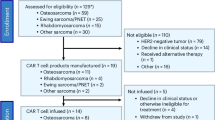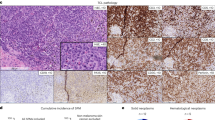Abstract
We have recently shown that lymphocyte and monocyte recovery by day +100 are associated with survival post myeloablative allogeneic hematopoietic transplant for acute leukemia. We hypothesized that lymphocyte and monocyte recovery would have a similar impact on survival in the reduced intensity setting. To test this hypothesis, we analyzed clinical data from 118 consecutive fludarabine/melphalan-conditioned patients by correlating peripheral blood absolute lymphocyte counts and monocyte counts (ALC and AMC, respectively) at days +15, +30, +60 and +100 with the outcomes. Multivariate analysis revealed that day +100 AMC (risk ratio (RR) 0.22, 95% confidence interval (CI) 0.07–0.73, P=0.01) and mild chronic GVHD (RR 0.09, 95% CI 0.005–0.43, P=0.008) were independently associated with survival. To explore whether the patterns of lymphocyte and monocyte recovery had a prognostic value, we performed unsupervised hierarchical clustering on the studied hematopoietic parameters and identified three patient clusters, A–C. Patient clusters A and B both had improved OS compared with cluster C (77.8 months vs not reached vs 22.3 months, respectively, P<0.001). No patient in cluster C had a day +100 AMC >300. Both severe acute GVHD and relapse occurred more frequently in cluster C. Our data suggest that patients with low AMC by day +100 post fludarabine/melphalan-conditioned allogeneic hematopoietic SCT may be at risk for poor outcomes.
This is a preview of subscription content, access via your institution
Access options
Subscribe to this journal
Receive 12 print issues and online access
$259.00 per year
only $21.58 per issue
Buy this article
- Purchase on Springer Link
- Instant access to full article PDF
Prices may be subject to local taxes which are calculated during checkout






Similar content being viewed by others
References
Pasquini MC, Wang Z . Current use and outcome of hematopoietic stem cell transplantation: CIBMTR Summary Slides, 2011. Available at http://www.cibmtr.org, 2011.
Morecki S, Gelfand Y, Nagler A, Or R, Naparstek E, Varadi G et al. Immune reconstitution following allogeneic stem cell transplantation in recipients conditioned by low intensity vs myeloablative regimen. Bone Marrow Transplant 2001; 28: 243–249.
Jimenez M, Martinez C, Ercilla G, Carreras E, Urbano-Ispizua A, Aymerich M et al. Reduced-intensity conditioning regimen preserves thymic function in the early period after hematopoietic stem cell transplantation. Exp Hematol 2005; 33: 1240–1248.
Friedman TM, Varadi G, Hopely DD, Filicko J, Wagner J, Ferber A et al. Nonmyeloablative conditioning allows for more rapid T-cell repertoire reconstitution following allogeneic matched unrelated bone marrow transplantation compared to myeloablative approaches. Biol Blood Marrow Transplant 2001; 7: 656–664.
Hentschke P, Omazic B, Mattsson J, Nasman-Bjork I, Lundkvist I, Gigliotti D et al. T-cell receptor Vbeta repertoire after myeloablative and reduced intensity conditioning allogeneic haematopoietic stem cell transplantation. Scand J Immunol 2005; 61: 285–294.
Klyuchnikov E, Asenova S, Kern W, Kilinc G, Ayuk F, Wiedemann B et al. Post-transplant immune reconstitution after unrelated allogeneic stem cell transplant in patients with acute myeloid leukemia. Leuk Lymphoma 2010; 51: 1450–1463.
Jimenez M, Ercilla G, Martinez C . Immune reconstitution after allogeneic stem cell transplantation with reduced-intensity conditioning regimens. Leukemia 2007; 21: 1628–1637.
Pavletic ZS, Joshi SS, Pirruccello SJ, Tarantolo SR, Kollath J, Reed EC et al. Lymphocyte reconstitution after allogeneic blood stem cell transplantation for hematologic malignancies. Bone Marrow Transplant 1998; 21: 33–41.
Kumar S, Chen MG, Gastineau DA, Gertz MA, Inwards DJ, Lacy MQ et al. Effect of slow lymphocyte recovery and type of graft-versus-host disease prophylaxis on relapse after allogeneic bone marrow transplantation for acute myelogenous leukemia. Bone Marrow Transplant 2001; 28: 951–956.
Kumar S, Chen MG, Gastineau DA, Gertz MA, Inwards DJ, Lacy MQ et al. Lymphocyte recovery after allogeneic bone marrow transplantation predicts risk of relapse in acute lymphoblastic leukemia. Leukemia 2003; 17: 1865–1870.
Kim DH, Sohn SK, Won DI, Lee NY, Suh JS, Lee KB . Rapid helper T-cell recovery above 200 × 10 6/l at 3 months correlates to successful transplant outcomes after allogeneic stem cell transplantation. Bone Marrow Transplant 2006; 37: 1119–1128.
Heining C, Spyridonidis A, Bernhardt E, Schulte-Monting J, Behringer D, Grullich C et al. Lymphocyte reconstitution following allogeneic hematopoietic stem cell transplantation: a retrospective study including 148 patients. Bone Marrow Transplant 2007; 39: 613–622.
Le Blanc K, Barrett AJ, Schaffer M, Hagglund H, Ljungman P, Ringden O et al. Lymphocyte recovery is a major determinant of outcome after matched unrelated myeloablative transplantation for myelogenous malignancies. Biol Blood Marrow Transplant 2009; 15: 1108–1115.
Matthews K, Lim Z, Pearce L, Pagliuca A, Alejandro MJ, Mufti GJ et al. Rapid recovery of lymphocyte subsets is not associated with protection from relapse of myelodysplastic syndromes and acute myeloid leukaemia after haematopoietic stem cell transplantation using a reduced intensity conditioning regimen and alemtuzumab. Br J Haematol 2010; 149: 879–889.
Buhlmann L, Buser AS, Cantoni N, Gerull S, Tichelli A, Gratwohl A et al. Lymphocyte subset recovery and outcome after T-cell replete allogeneic hematopoietic SCT. Bone Marrow Transplant 2010; 46: 1357–1362.
Burke MJ, Vogel RI, Janardan SK, Brunstein C, Smith AR, Miller JS et al. Early lymphocyte recovery and Outcomes after Umbilical Cord Blood Transplantation (UCBT) for Hematologic Malignancies. Biol Blood Marrow Transplant 2010; 17: 831–840.
Thoma MD, Huneke TJ, Decook LJ, Johnson ND, Wiegand RA, Litzow MR et al. Peripheral blood lymphocyte and monocyte recovery and survival in acute leukemia postmyeloablative allogeneic hematopoietic stem cell transplant. Biol Blood Marrow Transplant 2012; 18: 600–607.
Cox CJ, Habermann TM, Payne BA, Klee GG, Pierre RV . Evaluation of the Coulter counter model S-Plus IV. Am J Clin Pathol 1985; 84: 297–306.
Glucksberg H, Storb R, Fefer A, Buckner CD, Neiman PE, Clift RA et al. Clinical manifestations of graft-versus-host disease in human recipients of marrow from HL-A-matched sibling donors. Transplantation 1974; 18: 295–304.
Filipovich AH, Weisdorf D, Pavletic S, Socie G, Wingard JR, Lee SJ et al. National Institutes of Health consensus development project on criteria for clinical trials in chronic graft-versus-host disease: I. Diagnosis and staging working group report. Biol Blood Marrow Transplant 2005; 11: 945–956.
Kaplan E, Meier P . Nonparametric estimation from incomplete observations. J Am Stat Assoc 1958; 53: 457–481.
Hands S, Everitt B . A Monte Carlo Study of the recovery of cluster structure in binary data by techniques clustering techniques. Multivariate Behav Res 1987; 22: 235–243.
Matthews K, Lim Z, Pearce L, Pagliuca A, Alejandro Madrigal J, Mufti GJ et al. Rapid recovery of lymphocyte subsets is not associated with protection from relapse of myelodysplastic syndromes and acute myeloid leukaemia after haematopoietic stem cell transplantation using a reduced intensity conditioning regimen and alemtuzumab. Br J Haematol 2010; 149: 879–889.
Arpinati M, Chirumbolo G, Saunthararajah Y, Stanzani M, Bonifazi F, Bandini G et al. Higher numbers of blood CD14+ cells before starting conditioning regimen correlate with greater risk of acute graft-versus-host disease in allogeneic stem cell transplantation from related donors. Biol Blood Marrow Transplant 2007; 13: 228–234.
Ramirez P, Brunstein CG, Miller B, Defor T, Weisdorf D . Delayed platelet recovery after allogeneic transplantation: a predictor of increased treatment-related mortality and poorer survival. Bone Marrow Transplant 2011; 46: 981–986.
Mielcarek M, Martin PJ, Torok-Storb B . Suppression of alloantigen-induced T-cell proliferation by CD14+ cells derived from granulocyte colony-stimulating factor-mobilized peripheral blood mononuclear cells. Blood 1997; 89: 1629–1634.
Aranha FJ, Vigorito AC, De Sousa CA, Oliveira GB, Zulli R, Lorand-Metze I . The influence of the graft monocytes in the outcome of allogeneic bone marrow transplantation. Haematologica 2002; 87: 219–220.
Arpinati M, Chirumbolo G, Marzocchi G, Baccarani M, Rondelli D . Increased donor CD86+CD14+ cells in the bone marrow and peripheral blood of patients with chronic graft-versus-host disease. Transplantation 2008; 85: 1826–1832.
Rommeley M, Spies-Weisshart B, Schilling K, Hochhaus A, Sayer HG, Scholl S . Reconstitution and functional analyses of neutrophils and distinct subsets of monocytes after allogeneic stem cell transplantation. J Cancer Res Clin Oncol 2011; 137: 1293–1300.
Acknowledgements
We extend our gratitude to the blood and marrow transplant database managers who assisted in data collection for this work.
Author information
Authors and Affiliations
Corresponding author
Ethics declarations
Competing interests
The authors declare no conflict of interest.
Rights and permissions
About this article
Cite this article
DeCook, L., Thoma, M., Huneke, T. et al. Impact of lymphocyte and monocyte recovery on the outcomes of allogeneic hematopoietic SCT with fludarabine and melphalan conditioning. Bone Marrow Transplant 48, 708–714 (2013). https://doi.org/10.1038/bmt.2012.211
Received:
Revised:
Accepted:
Published:
Issue Date:
DOI: https://doi.org/10.1038/bmt.2012.211



